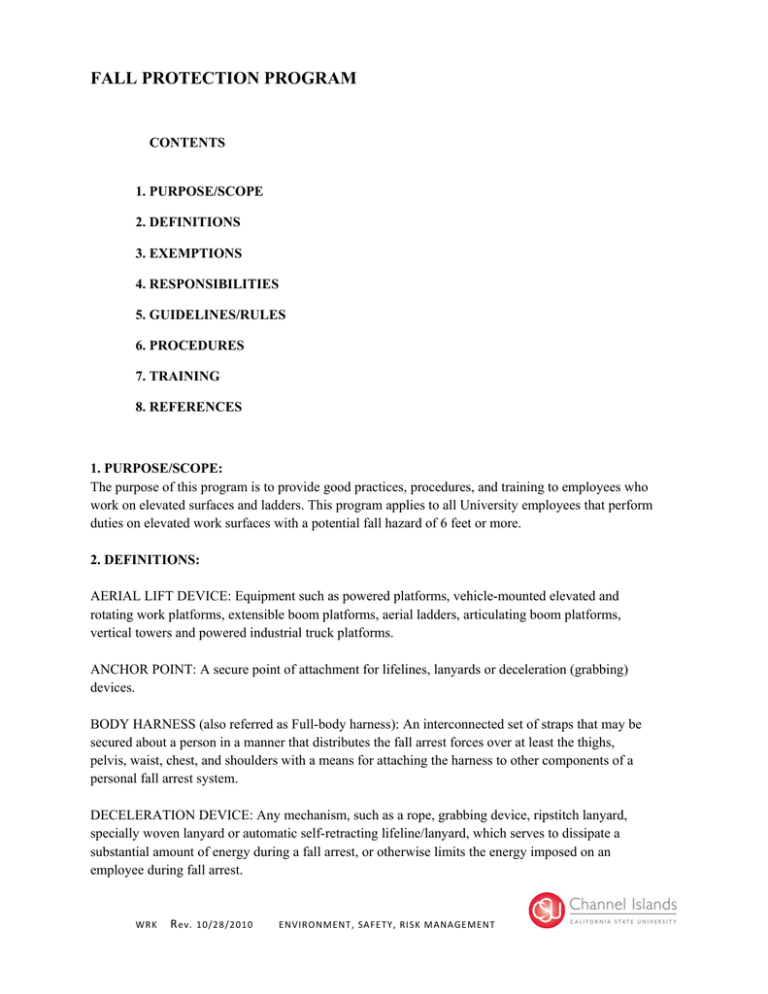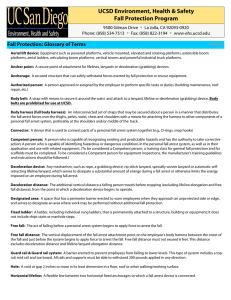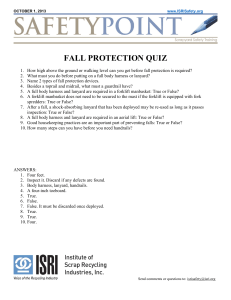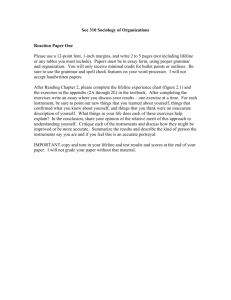FALL PROTECTION PROGRAM
advertisement

FALL PROTECTION PROGRAM CONTENTS 1. PURPOSE/SCOPE 2. DEFINITIONS 3. EXEMPTIONS 4. RESPONSIBILITIES 5. GUIDELINES/RULES 6. PROCEDURES 7. TRAINING 8. REFERENCES 1. PURPOSE/SCOPE: The purpose of this program is to provide good practices, procedures, and training to employees who work on elevated surfaces and ladders. This program applies to all University employees that perform duties on elevated work surfaces with a potential fall hazard of 6 feet or more. 2. DEFINITIONS: AERIAL LIFT DEVICE: Equipment such as powered platforms, vehicle-mounted elevated and rotating work platforms, extensible boom platforms, aerial ladders, articulating boom platforms, vertical towers and powered industrial truck platforms. ANCHOR POINT: A secure point of attachment for lifelines, lanyards or deceleration (grabbing) devices. BODY HARNESS (also referred as Full-body harness): An interconnected set of straps that may be secured about a person in a manner that distributes the fall arrest forces over at least the thighs, pelvis, waist, chest, and shoulders with a means for attaching the harness to other components of a personal fall arrest system. DECELERATION DEVICE: Any mechanism, such as a rope, grabbing device, ripstitch lanyard, specially woven lanyard or automatic self-retracting lifeline/lanyard, which serves to dissipate a substantial amount of energy during a fall arrest, or otherwise limits the energy imposed on an employee during fall arrest. WRK R ev. 10/28/2010 ENVIRONMENT, SAFETY, RISK MANAGEMENT DECELERATION DISTANCE: The additional vertical distance a falling person travels, excluding lifeline elongation and free fall distance, before stopping, from the point at which a deceleration device begins to operate. DESIGNATED AREA: A space which has a perimeter barrier erected to warn employees when they approach an unprotected side or edge, and serves also to designate an area where work may be performed without additional fall protection. FIXED LADDER: Any ladder, including an individual rung ladder, which is permanently attached to a structure, building, or equipment. GUARDRAIL: A vertical barrier erected along the open edges of a floor opening, wall opening, ramp, platform, runway, or other elevated area to prevent falls of persons. LADDER: A device typically used to gain access to a different elevation consisting of two or more structural members crossed by rungs, steps, or cleats. LANYARD: A flexible line of rope or strap that generally has a connector at each end for connecting the body harness to a deceleration device, lifeline or anchor point. LIFELINE: A component consisting of a flexible line for connection to an anchorage at one end to hang vertically (vertical lifeline), or for connection to anchorages at both ends to stretch horizontally (horizontal lifeline). This serves as a means for connecting other components of a personal fall arrest system to the anchorage. LOW SLOPE ROOF: A roof having a slope of less than or equal to 4 in 12 (vertical to horizontal). A roof with approximately a 19.5 degree slope or less. LOWER LEVELS: Those areas or surfaces to which an employee can fall. Such areas include, but are not limited to, ground levels, floors, platforms, ramps, runways, excavations, pits, tanks, material, water, equipment, structures, or portions thereof. OPENING: A gap or void 30 inches or more high and 18 inches or more wide in a wall or partition, through which personnel can fall to a lower level. POSITIONING DEVICE SYSTEM: A body harness system rigged to allow an employee to be supported on an elevated vertical surface such as a wall and work with both hands free while leaning. PERSONAL FALL ARREST SYSTEM: A system used to arrest an employee in a fall from a working level. It consists of an anchorage, connectors, and body harness and may include a lanyard, deceleration device, lifeline, or suitable combinations of these. ROPE GRAB (grabbing device): A deceleration device that travels on a lifeline and automatically, by WRK R ev. 10/28/2010 ENVIRONMENT, SAFETY, RISK MANAGEMENT friction, engages the lifeline and locks to arrest a fall. SCAFFOLD: Any temporary elevated or suspended platform, and its supporting structures, used for supporting employees or materials or both. SELF-RETRACTING LIFELINE/LANYARD: A deceleration device containing a drum-wound line which can be slowly extracted from, or retracted onto, the drum under minimal tension during normal movement and which, after onset of a fall, automatically locks the drum and arrests the fall (usually within two feet or less). STANDARD RAILING: A vertical barrier erected along exposed edges of a floor opening, wall opening, ramp, platform, or runway to prevent falls of persons. SNAP HOOK: A connector consisting of a hook-shaped member with a normally closed keeper, or similar arrangement, which may be opened to permit the hook to receive an object and, when released automatically closes to retain the object. TOE BOARD: A vertical protective barrier affixed to the scaffold or platform floor that prevents tools, material and equipment from falling to lower levels. TIE-OFF: A procedure of connecting directly or indirectly to an anchorage point. UNPROTECTED SIDES AND EDGES: Any side or edge (except at entrances to points of access) of a walking/working surface, e.g., floor, roof, ramp, or runway where there is no wall or guardrail system at least 42 inches high. VERTICAL LIFELINE: A vertically hanging flexible line for connection to an anchor point at one end that serves as a means for connecting other components of a personal fall arrest system to the anchor point. 3. EXEMPTIONS: Employees may work without fall protection: • When using portable ladders up to 40 feet in length • At the working sides of loading docks • At the exposed perimeters of theater stages 4. RESPONSIBILITIES: Environment, Safety and Risk Management: • Establish and update a Fall Protection Safety Program • Provide consultation and training to departments as necessary WRK R ev. 10/28/2010 ENVIRONMENT, SAFETY, RISK MANAGEMENT • Assist departments in determining when, where, and how fall projection may be applied. • Assist each department in identifying elevated work areas. • Assist departments in determining which fall protective system will work best for each elevated work situation. Supervisors • Identify and maintain records of all areas/tasks/employees who are required to wear fall protection. • Responsible for ensuring new and existing employees receive fall protection training as applicable to their job duties. • Maintain training records. • With the assistance of Environmental Health and Safety, are responsible for identifying elevated work areas. • With the assistance of Environmental Health and Safety, are responsible for determining applicable fall protective measures based on above task/location. Employees • Must not use fall protection equipment without prior training • Follow all appropriate Fall Protection requirements while performing assigned duties. • Inspect fall protective equipment prior to each use. • Report conditions to your supervisor which may lead to falls. 5. GUIDELINES/RULES: 5.1. The following items are covered by the University’s Fall Protection Program: • Ladders – fixed, portable, free standing, temporary, or roll away type • Elevating Personal Platforms – scaffolds, aerial platforms, scissor lifts, forklift-mounted platforms, bucket trucks, etc. • Vertical Openings – ground level entry into excavation, trenches, holes, pits, vessels and other confined spaces. 5.2. Fall protection is required whenever work is performed in an area 6 feet above its surroundings. Fall protective systems may consist of: • Guardrails – Standard guardrails consist of a top rail, located 42 inches above the floor and a mid-rail. Screens and mesh may be used to replace the mid-rail, provided they extend from the top rail to the floor. • Personal Fall Arresting Systems – Components of a personal fall arresting system include a body harness, lanyard, lifeline, connector, and an anchorage point capable of supporting at WRK R ev. 10/28/2010 ENVIRONMENT, SAFETY, RISK MANAGEMENT least 5000 pounds • Positioning Device Systems – Positioning device systems consist of a body belt or harness rigged to allow work on vertical surfaces, such as a wall, with both hands free. • Warning Line Systems – warning line systems are made up of lines or ropes installed around a work area on a roof. These act as a barrier to prevent those working on the roof from approaching the edges. • Covers - Covers are fastened over holes in the working surface to prevent falls. If it can be clearly demonstrated that use of these systems is impracticable or creates a greater hazard, alternative fall protection methods may be implemented. 5.3. Record Keeping: Training records shall be maintained for a minimum of 3 years. 6. PROCEDURES: 6.1. Employees who work on ladders with a working height of 6 feet or more must be knowledgeable of the following: • How to inspect ladders to ensure ladder is in safe working order. • How to use ladders properly. 6.2. Employees who use personal fall arresting systems to control potential fall injuries in their work area shall be knowledgeable of the following: • The application limits of the equipment. • The proper hook-up, anchoring, and tie-off techniques including determination of elongation and deceleration distances. • Methods of use, inspection, and storage of equipment. Personal fall arrest components including harnesses and lanyards should be inspected before each use for the presence of mildew, wear, damage and other imperfections. Defective components shall be removed from service. Fall arrest systems including harnesses are to be inspected twice each year or according to manufacturer’s recommendations. The date of the most current semi-annual inspection shall be recorded on an inspection tag which shall be attached to the harness. In addition, separate records shall be kept and maintained showing date of purchase, dates when attachments were renewed, and dates when the entire harness assembly was inspected and by whom. 6.3 Employees who use aerial lifts must be knowledgeable of the following: WRK R ev. 10/28/2010 ENVIRONMENT, SAFETY, RISK MANAGEMENT • The manufacturer’s operating instructions. • Pre-start inspection of the lift. • Inspection of the work area for dangerous conditions such as uneven surfaces, overhead obstructions such as power lines, or other hazards. • Load capacities of the equipment • How to safely move the equipment • How to prevent falls and use appropriate fall protection personal protective equipment • Minimum safe approach distances to energized power lines. 6.4 University employees who work on scaffolds must be knowledgeable of the following: • The possibilities of electrical hazards, fall hazards and falling object hazards in the work area. • The correct procedure for erecting, securing, maintaining and disassembling the fall protective systems and falling object protection systems used. • The proper use/construction of the scaffold. • The proper handling of materials on the scaffold. • The maximum load and carrying capacities of the scaffolds. 7. TRAINING: 7.1. Scope: All employees working on elevated work surfaces of 6 feet or more must receive training. All supervisors whose employees work at/on elevated work surfaces and may be required to utilize fall protective equipment/systems shall also receive training. No university employee shall work in areas of high fall hazards or perform duties requiring the use of fall protection devices until he/she has completed training in fall protection. 7.2. Employee Training: Training shall be provided for all employees working on job tasks related to elevated platforms. Training shall include the following: • Classroom training. • On the job training. • Inspection, care and use of personal fall protective equipment • Emergency action plan, in case of a fall. • Demonstrating competency in operating equipment safely. • Employees will require retraining under any of the following conditions: • Changes in workplace responsibility. • Changes in the types of fall protection systems or equipment to be used. WRK R ev. 10/28/2010 ENVIRONMENT, SAFETY, RISK MANAGEMENT • Inadequacies in an employee’s knowledge of fall protection systems, equipment or observed behavior which demonstrates the employee has not obtained the required training. 7.3. Supervisor Training; • Supervisors shall receive training on the following topics prior to being assigned to supervise employees who work on elevated surfaces. • The training information required of the employees, detailed above. • Procedures the supervisor is to follow to implement the provisions of this program. 8. REFERENCES: Title 8 California Code of Regulations, General Industry Safety Orders - §3210 , §3212 , §3213 , §3214 , §3287 , §3298 , §3299 , §3416 , §3275, §3276, §3277, §3278, §3279, §3280. American National Standards Institute (ANSI), Safety Requirements for Personal Fall Arrest Systems, Subsystems and Components (ANSI Z359.1-1992) WRK R ev. 10/28/2010 ENVIRONMENT, SAFETY, RISK MANAGEMENT




